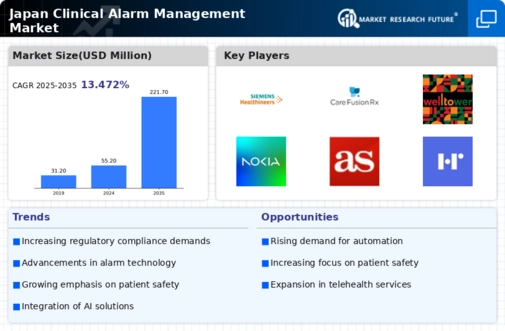The clinical alarm-management market in Japan is characterized by a dynamic competitive landscape, driven by technological advancements and an increasing focus on patient safety. Key players such as Philips (NL), GE Healthcare (US), and Nihon Kohden (JP) are at the forefront, leveraging innovation and strategic partnerships to enhance their market positions. Philips (NL) emphasizes digital transformation, integrating advanced analytics into its alarm systems to reduce alarm fatigue and improve clinical outcomes. Meanwhile, GE Healthcare (US) focuses on regional expansion, enhancing its product offerings to cater to the unique needs of Japanese healthcare providers, thereby strengthening its competitive edge. Nihon Kohden (JP), a domestic leader, is concentrating on localized solutions that align with Japan's healthcare regulations and practices, which further shapes the competitive environment.
The market structure appears moderately fragmented, with several players vying for market share through various business tactics. Companies are increasingly localizing manufacturing to reduce costs and optimize supply chains, which is crucial in a market where operational efficiency can significantly impact profitability. The collective influence of these key players fosters a competitive atmosphere where innovation and responsiveness to market demands are paramount.
In September 2025, Philips (NL) announced a partnership with a leading Japanese hospital network to implement its latest alarm management system, which utilizes AI to prioritize alerts based on patient conditions. This strategic move is likely to enhance patient safety and streamline clinical workflows, positioning Philips as a leader in the integration of AI within alarm management. The collaboration underscores the importance of aligning technological advancements with local healthcare needs.
In October 2025, GE Healthcare (US) launched a new alarm management software tailored specifically for the Japanese market, which incorporates feedback from local healthcare professionals. This initiative not only demonstrates GE's commitment to understanding regional requirements but also enhances its competitive positioning by offering customized solutions that address specific challenges faced by Japanese healthcare providers. Such tailored approaches may lead to increased market penetration and customer loyalty.
In August 2025, Nihon Kohden (JP) expanded its product line to include advanced alarm systems that integrate seamlessly with existing hospital infrastructure. This strategic expansion reflects the company's focus on innovation and its ability to adapt to the evolving needs of the healthcare sector in Japan. By enhancing interoperability, Nihon Kohden is likely to strengthen its market presence and foster long-term relationships with healthcare institutions.
As of November 2025, the competitive trends in the clinical alarm-management market are increasingly defined by digitalization, sustainability, and the integration of AI technologies. Strategic alliances among key players are shaping the landscape, facilitating the sharing of resources and expertise. Looking ahead, competitive differentiation is expected to evolve, with a shift from price-based competition to a focus on innovation, technological advancements, and supply chain reliability. Companies that can effectively leverage these trends are likely to secure a more robust position in the market.

















Leave a Comment